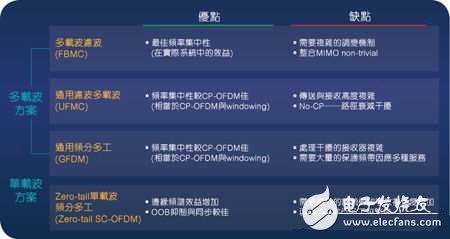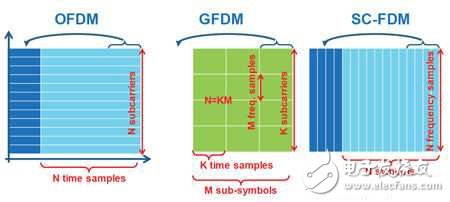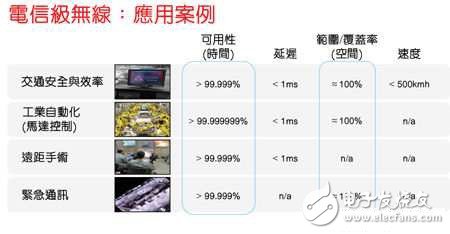Professor Dulden University of Technology (Tu Dresden) and Vodafone Chair Mobile CommunicaTIons Systems project coordinator Gerhard Fettweis is convinced that it is ready for the next generation of 5G cellular network intermediaries. He believes that Generalized Frequency Division Multiplexing (GFDM) has obvious advantages and can support what he calls the haptic Internet. This is also the future of the Internet of Things (IoT). He has already obtained Huawei, Intel, and Support from companies such as National Instruments (NI), Vodafone, and Xilinx.
All parties agree that 5G needs a new air intermediary to meet its ambitions, because 5G is not backward compatible with current 4G LTE. The industry has so far proposed six major recommendations, and it is expected that more proposals will emerge before 3GPP releases the first major 5G standard by Release 15 in 2018.
Most of the proposals are current versions of Orthogonal Frequency Division Multiplexing (OFDM) technology that will further enhance the power of supporters. Some experts believe that the competition for empty intermediaries is not as intense as defining new technologies for large-scale antenna arrays and supporting frequencies above 6 GHz.
Despite this, many companies and research institutions have begun to focus on adopting empty intermediaries that they believe will bring the greatest benefits to the industry and themselves. The differences between these empty intermediaries involve subtle trade-offs in wireless communication technology.
"The beauty contest" of the coding mechanism
"It's a bit like a beauty contest. In the end, it may adopt some of the many proposals, but it is not too complicated. Because the technology has basic substantive laws, we can't optimize for all aspects," experienced researchers. And entrepreneur Arogyaswami Paulraj said at the recent IEEE 5G Summit.
John Smee, senior engineering director for 5G at Qualcomm Research, a division of Qualcomm's research department, agrees. The various proposals are nothing more than making a fuss about opening and filtering OFDM signals, he pointed out.
Despite this, Qualcomm recently published its own proposal. Its unified OFDM interface uses a hybrid approach using multiple techniques to support multiple symbols at the power of two, making it more suitable for semiconductor designs. Qualcomm has proposed another 5G approach to the Internet of Things with limited resources.
Fettweis described Qualcomm's unified interface as a variant of the time/frequency code segmentation concept that researchers have studied for many years. He believes that this approach may not have the highest energy efficiency, but rather to form analog components with relatively large power consumption, such as ADCs and radio frequency (RF) chips.

Qualcomm describes the view of 5G air intermediaries in a recently published white paper
(Source: Qualcomm)
Mapping empty mediation map

GFDM aims to support multi-carriers through a hybrid approach
Like other methods, researchers and companies in Scandinavia have expressed support for Multi-Carrier Filtering (FBMC) technology. Paulraj said that the FBMC method provides the best extra-radiation performance, but because of its long window, it is not conducive to large antenna arrays planned for 5G.
The Universal Filtered Multi-Carrier (UFMC) approach is also not very good at extra-radio performance, but it performs better on the base station's shared uplink, Paulraj points out. “Like sandbags, you punch a punch from one side. In the past, the other side was bulging."
According to Fettweis, Alcatel-Lucent supports UFMC and calls it a way to support multi-carrier systems on subcarrier channels. If it uses its "tail-biTIng" method for filtering, it is also compatible with its GFDM, he said.
Huawei claims to support an OFDM approach called spectrum filtering, which is closer to the capacity limit of Shannon's Law. However, Fettweis pointed out that this approach requires more complex receivers and antenna arrays.
At least one startup has come up with a new approach to OFDM, which is Cohere Technologies. The company uses innovative mathematical concepts to provide channel estimates more accurately, which in turn increases spectral efficiency. Cohere is currently preparing a white paper and plans to publish some details of the concept for the first time.
Paulraj said, "We need more ideas before everything settles."
Low latency implementation of haptic internet
Fettweis sees its GFDM as a super-aggregate approach that is compatible with multiple proposals based on how it is built. One of its key components is the wraparound processing method for the filter module, which is said to help keep the data packets shorter and thus achieve millisecond delays.
Fettweis explained, "We proposed a loop filtering technique, so if a data packet is 70ms long, the time to filter the entire data packet is still 70ms long."
This approach also maintains a low peak-to-average power ratio, ensuring that the power amplifier is performing at a low power state. “We have shown that this ratio will not deteriorate, and in most cases there will be significant improvements in using our method,†Fettweis pointed out.
This approach opens the door to new use cases for the Internet of Things. Fettweis and other researchers have summarized these use cases in a concept they call the haptic Internet. These use cases include wireless versions of multi-user gaming, virtual reality, retail product demonstrations, and industrial, robotic, and medical controls for a variety of remote systems management.

Fettweis has developed a new application case with only a millisecond delay
For example, given the current wireless latency of up to 150ms, users cannot use a virtual reality (VR) head-mounted display to respond in a timely manner. But when the delay is reduced to 5ms, such a task is quite easy.
Researchers at Ericsson and King's College London are currently collaborating on the development of the tactile Internet. For example, Mischa Dohler of the lab's wireless communications division said they hope to further promote the standardization of haptic codecs and encoders.
The tactile Internet can be derived from the IoT version of Facebook, which Fettweis calls the Thingbook, a web interface that interacts with smart objects.
“There are currently five large companies investing millions of dollars each year on GFDM, indicating that a large group is widely accepting GFDM.†Fettweis, who is currently applying for GFDM patents through Vodafone, revealed that “Huawei has a large group of people. Desperate to write a patent on GFDM."
The pursuit of low latency has also attracted criticism from many people. For example, Qualcomm said that GFDM requires complex receivers to handle interference, and must also provide a larger guard band for multiplex services.
Proponents of the Cloud Wireless Access Network (C-RAN) believe that the low latency of GFDM may conflict with its target. The C-RAN aims to transform the base station into a simple antenna array, then feed the signal back to the huge data center and process it on a standard server. This approach eliminates the need for large system cabinets where the cellular antenna tower typically requires air conditioning.
TIbor Boros, senior director of Google Access, which is currently building a wireless communications business for search engine giant Google, said: "C-RAN is ideal because it reduces the power and cost of the infrastructure, allowing anyone to write for the cellular network. Software, and virtualizing the cellular network is very exciting."
"However, if the latency is low, C-RAN is not as good, because the physical layer must be closer to the edge or even the core network," Boros pointed out.
Fettweis calls C-RAN "a good concept. However, once the base station has many antennas, it will collapse, because each antenna requires a Gbit/s link to connect to the cloud server. Therefore, if 5G is used in the future. With 100 base station antennas available, a number of Tbit/s links will be required from the base to the C-RAN signal processing engine."
Still, Fettweis believes that there are still many ways to eliminate the conflict between C-RAN and low latency. For example, an operator can install a cloud server at the edge of the network, which he estimates may be within a mile of any C-RAN wireless headend.
(Reference: 5G Idea Opens IoT Horizons, by Rick Merritt)
Pneumatic Telescopic Mast
Pneumatic telescopic mast with power of air source, promote the movement of multicylinder through air compression to lift the mast. Pneumatic telescopic mast industry has experienced a rapid development recently. This mast has been widely used in various fields such as illumination, communication, disaster relief and etc. Due to the features of light loading, general structures, normal maintenance, high security, extreme weather, pneumatic masts have been recognized gradually.
Pneumatic Telescopic Mast,Tower Pneumatic Telescopic Mast,Aluminum Pneumatic Telescopic Mast,Vehicle Mounted Pneumatic Telescopic Mast
Yixing Steel Pole International Trading Co., Ltd , https://www.yx-steelpole.com
